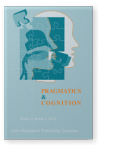Vol. 19:3 (2011) ► pp.422–447
Turning speaker meaning on its head
Non-verbal communication and intended meanings
This article addresses the issue of non-verbal communication in the light of the Gricean conceptualisation of intentionally conveyed meanings. The first goal is to testify that non-verbal cues can be interpreted as nonnatural meanings and speaker meanings, which partake in intentional communication. Secondly, it is argued that non-verbal signals, exemplified by gestures, are similar to utterances which generate the communicator’s what is said and/or conversational implicatures, together with their different subtypes and manifestations. Both of these objectives necessitate a critical overview of Grice’s work on the focal aspects of meaning and communication, also on the strength of neo-Gricean research.
Cited by (6)
Cited by 6 other publications
This list is based on CrossRef data as of 15 july 2024. Please note that it may not be complete. Sources presented here have been supplied by the respective publishers. Any errors therein should be reported to them.
